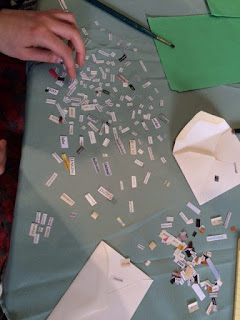Monika Gross
Asheville, NorthCarolina
January- February 2016
They Came, They Chopped, They Poemed & Pickled
On Saturday, February 6, 2016, the last day of my
four-week residency at the Rensing Center, director Ellen Kochansky and
crew hosted a community workshop called CABBAGE POETRY in my “home away from home”,
the Pottery studio. Though I am not a potter, I was able to throw myself into
my work in this open and inviting space while on my retreat. I worked deeply
into my writing project, a theater adaptation of the correspondence of American
poets Denise Levertov and Robert Duncan. Now I was making my transition from
solitude and internal action back into my “civilian” life as mom and wife. I
needed a good transitional ritual, and a workshop in devised poetry mixed with
natural fermentation should be just the ticket.
At 8AM I built a healthy fire in the woodstove to
warm the space for the dozen people who would be attending the 10AM-2PM
workshop. This woodstove and I had bonded during my stay. Any of you who use
woodstoves for heat know about that special hearth relationship, kind of like
keeping a writing project alive, where you are always aware of the condition of
your fire, always calculating when the next log should be added. Rule #1: Do
not burn out! Tending the fire. Feeding the flames. Not wasting wood by
carelessly sacrificing logs haphazardly. Blowing on the coals to seduce out as
if by magic new flames to feed on a new log.
Gradually the others arrived. First came Clemson
history professor Pam Mack and her daughter, Elizabeth Mauer. They were leading
the fermentation workshop. We set up folding tables and cleared surface space
in the kitchen, laid out salt and cabbages and bowls and knives. Katie Nocella,
the assistant to the director for the Rensing Center, brought quiches and
salads for our lunch break. John had brought some roasted wild boar - culled locally, for delicious tacos carnitas. Director Ellen Kochansky and her 95-year-old
mother, Evelyn Rensing Kochansky, for whom the center is named, arrived and
made sure nothing was wanting or needed. We fashioned a cabbage centerpiece and
two long lettuces in vases for the table.
Voilà. We were ready.
 |
| Abby Minor sees poetry everywhere |
With a title like CABBAGE POETRY, I expected this
event to have a certain Dada-Meets-Sauerkraut flavor, and I was not disappointed. My
fellow resident artist, writer Abby Minor, had given some hours of her precious
retreat time to patiently cutting up tiny words from catalogs and placing
them in little envelopes for us. We each got an envelope of tiny word bits, a
section of old faded blue, green or brick colored cardboard folders, a bit of
white glue in a cup, and a paintbrush. And time.
We
sat on the four sides of the doubled-together folding tables covered with a
green tablecloth - 3 x 3 x 3 x 3 – and we created poems from what we were
given. As in life. We all wanted more time. Abby was a benevolent poet-fairy
and granted it
Afterwards, we read
our poems to each other, in no particular order. I wrote two. Here is one:
Greek lessons
its
molecules
Brushed
the first scarlet motion
sunscald
Impossible
problem.
made of part
solution
decades long
solution
product
production product
decades later
the first
picking
it's
harvested
The poems were set out to dry on the piano.
Then the rest of the morning was spent chopping and salting our cabbages,
Ellen showed us how to make pickled lemon
rind.
Throughout we listened with fascination to the knowledgeable narratives
of Pam and Elizabeth as they shared simple, old-fashioned methods of making
fermented foods based on their experience with the natural fermentation process
popularized by Sandor Katz. We learned about scoby (Symbiotic
Colony Of Bacteria and Yeast), dead yeast, and that we were all
covered with loads of bacteria that could pickle just about anything. I never realized how much fizzy fun bacteria
could provide!
After everyone left it was quiet in the Pottery. I
knew it had successfully made its transition back into a communal Rensing
Center space again. I was ready to pack my car to the gills and head back to
Asheville. The Pottery was ready for the next resident artist to arrive:
Kathryn Field, a visual artist coming from New Hampshire. And the next who
would follow her. And the next. The tiny word bits would form new poems and the
natural fermentation processes of creativity would symbiotically colonize new
art scoby in the briny generosity of the Rensing Center.
 |
| Fellow artist in residence, visual artist So Hee Kim |
 |
| Monika Gross performing as poet Denise Levertov |





















